A Report on Instruments, Equipment, and Cross-Infection in Dental Care
VerifiedAdded on 2020/07/23
|12
|3588
|146
Report
AI Summary
This report provides a comprehensive overview of instruments and equipment utilized in clinical dental care, emphasizing the critical importance of infection control. It delves into the causes and methods of preventing cross-infection, highlighting the significance of standard precautions, including personal protective equipment, hand hygiene, and environmental cleaning. The report details the importance of maintaining equipment according to manufacturer's instructions, defines key terms such as sterilization and disinfection, and outlines procedures for checking equipment before use. It further addresses the potential risks associated with inadequate decontamination, improper waste disposal, and the use of damaged or pre-used sterile goods. The report also covers different types of waste generated in dental surgery and the appropriate disposal methods, offering practical guidance for maintaining a safe and hygienic environment. In essence, the report underscores the critical role of proper equipment management and infection control in ensuring patient safety and preventing the spread of infectious diseases in dental settings.
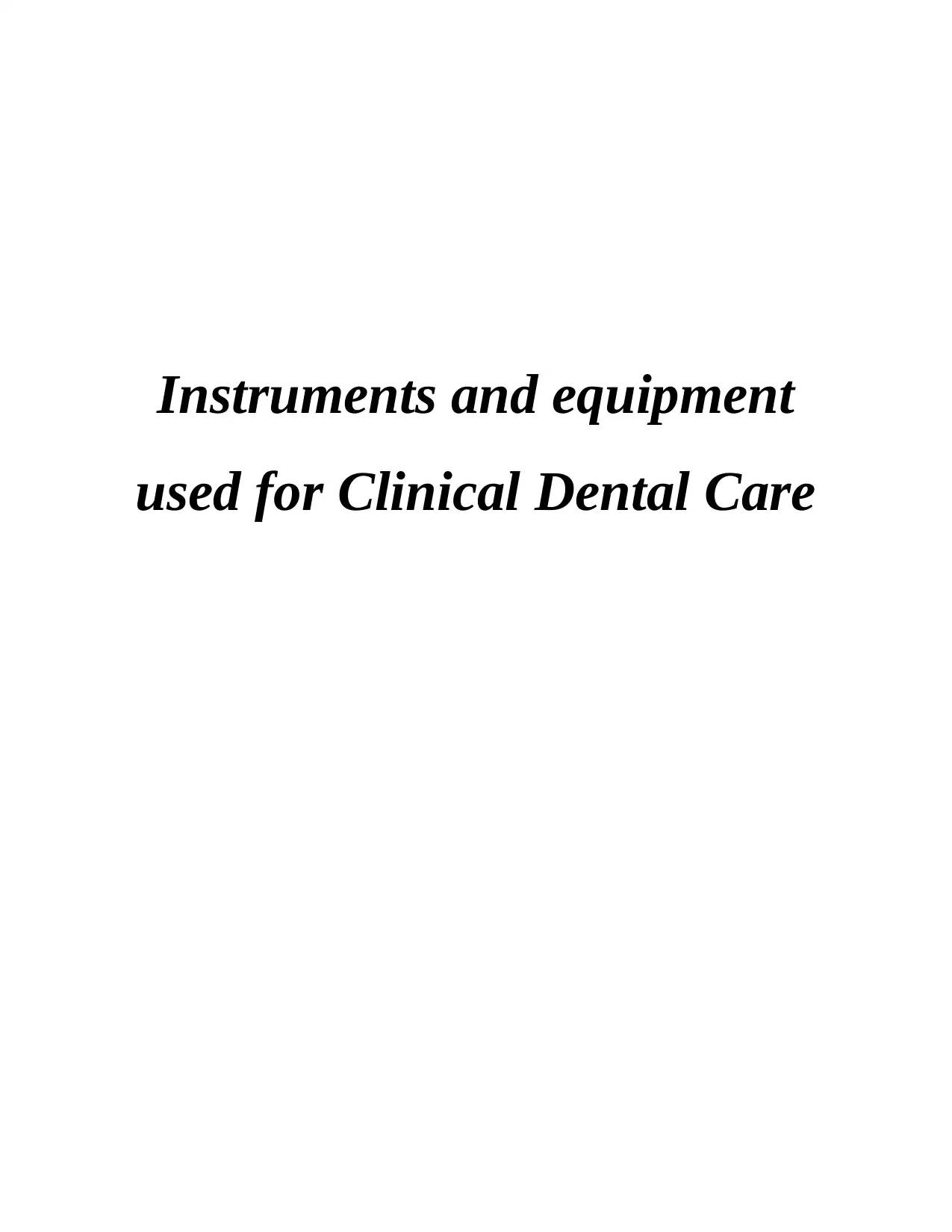
Instruments and equipment
used for Clinical Dental Care
used for Clinical Dental Care
Paraphrase This Document
Need a fresh take? Get an instant paraphrase of this document with our AI Paraphraser
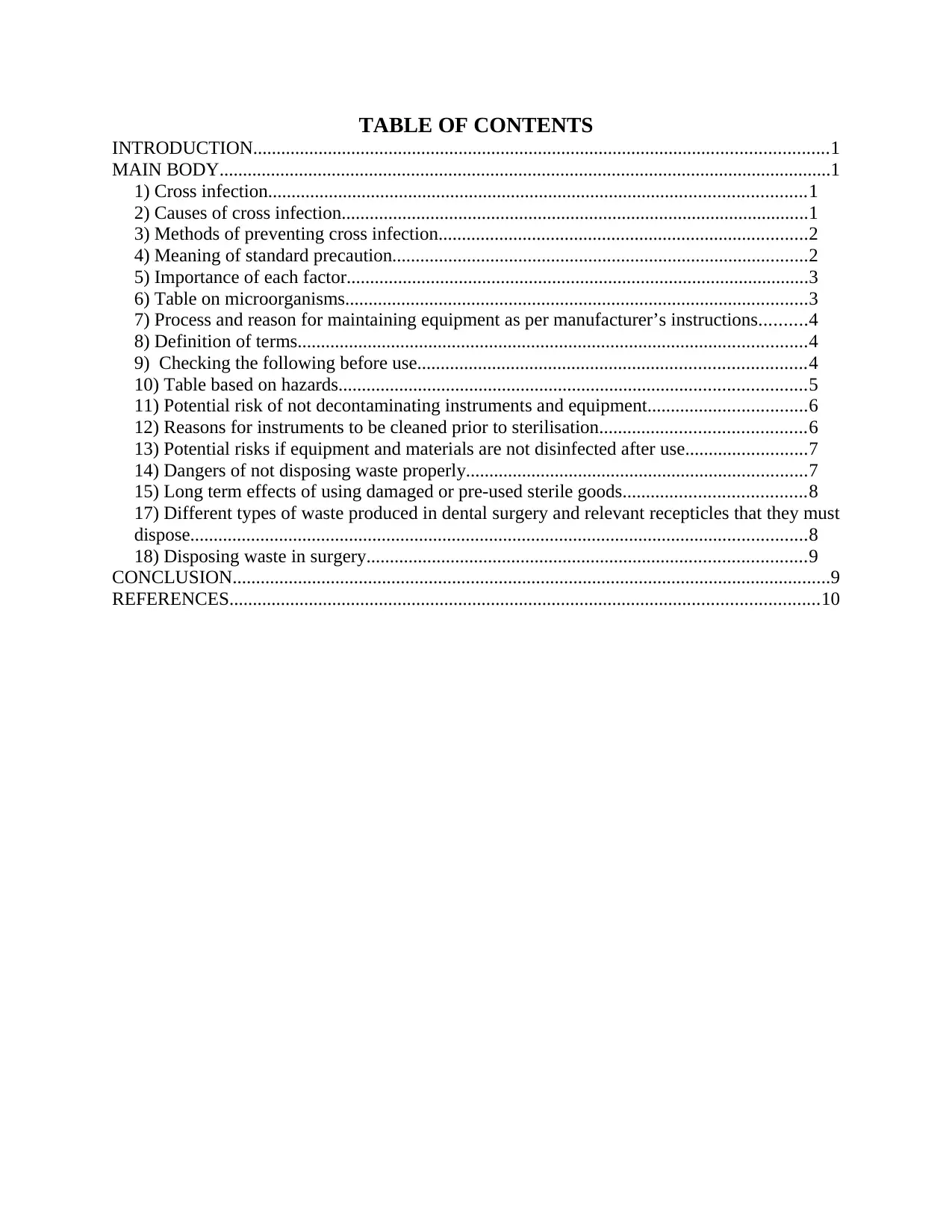
TABLE OF CONTENTS
INTRODUCTION...........................................................................................................................1
MAIN BODY...................................................................................................................................1
1) Cross infection...................................................................................................................1
2) Causes of cross infection....................................................................................................1
3) Methods of preventing cross infection...............................................................................2
4) Meaning of standard precaution.........................................................................................2
5) Importance of each factor...................................................................................................3
6) Table on microorganisms...................................................................................................3
7) Process and reason for maintaining equipment as per manufacturer’s instructions..........4
8) Definition of terms.............................................................................................................4
9) Checking the following before use...................................................................................4
10) Table based on hazards....................................................................................................5
11) Potential risk of not decontaminating instruments and equipment..................................6
12) Reasons for instruments to be cleaned prior to sterilisation............................................6
13) Potential risks if equipment and materials are not disinfected after use..........................7
14) Dangers of not disposing waste properly.........................................................................7
15) Long term effects of using damaged or pre-used sterile goods.......................................8
17) Different types of waste produced in dental surgery and relevant recepticles that they must
dispose....................................................................................................................................8
18) Disposing waste in surgery..............................................................................................9
CONCLUSION................................................................................................................................9
REFERENCES..............................................................................................................................10
INTRODUCTION...........................................................................................................................1
MAIN BODY...................................................................................................................................1
1) Cross infection...................................................................................................................1
2) Causes of cross infection....................................................................................................1
3) Methods of preventing cross infection...............................................................................2
4) Meaning of standard precaution.........................................................................................2
5) Importance of each factor...................................................................................................3
6) Table on microorganisms...................................................................................................3
7) Process and reason for maintaining equipment as per manufacturer’s instructions..........4
8) Definition of terms.............................................................................................................4
9) Checking the following before use...................................................................................4
10) Table based on hazards....................................................................................................5
11) Potential risk of not decontaminating instruments and equipment..................................6
12) Reasons for instruments to be cleaned prior to sterilisation............................................6
13) Potential risks if equipment and materials are not disinfected after use..........................7
14) Dangers of not disposing waste properly.........................................................................7
15) Long term effects of using damaged or pre-used sterile goods.......................................8
17) Different types of waste produced in dental surgery and relevant recepticles that they must
dispose....................................................................................................................................8
18) Disposing waste in surgery..............................................................................................9
CONCLUSION................................................................................................................................9
REFERENCES..............................................................................................................................10
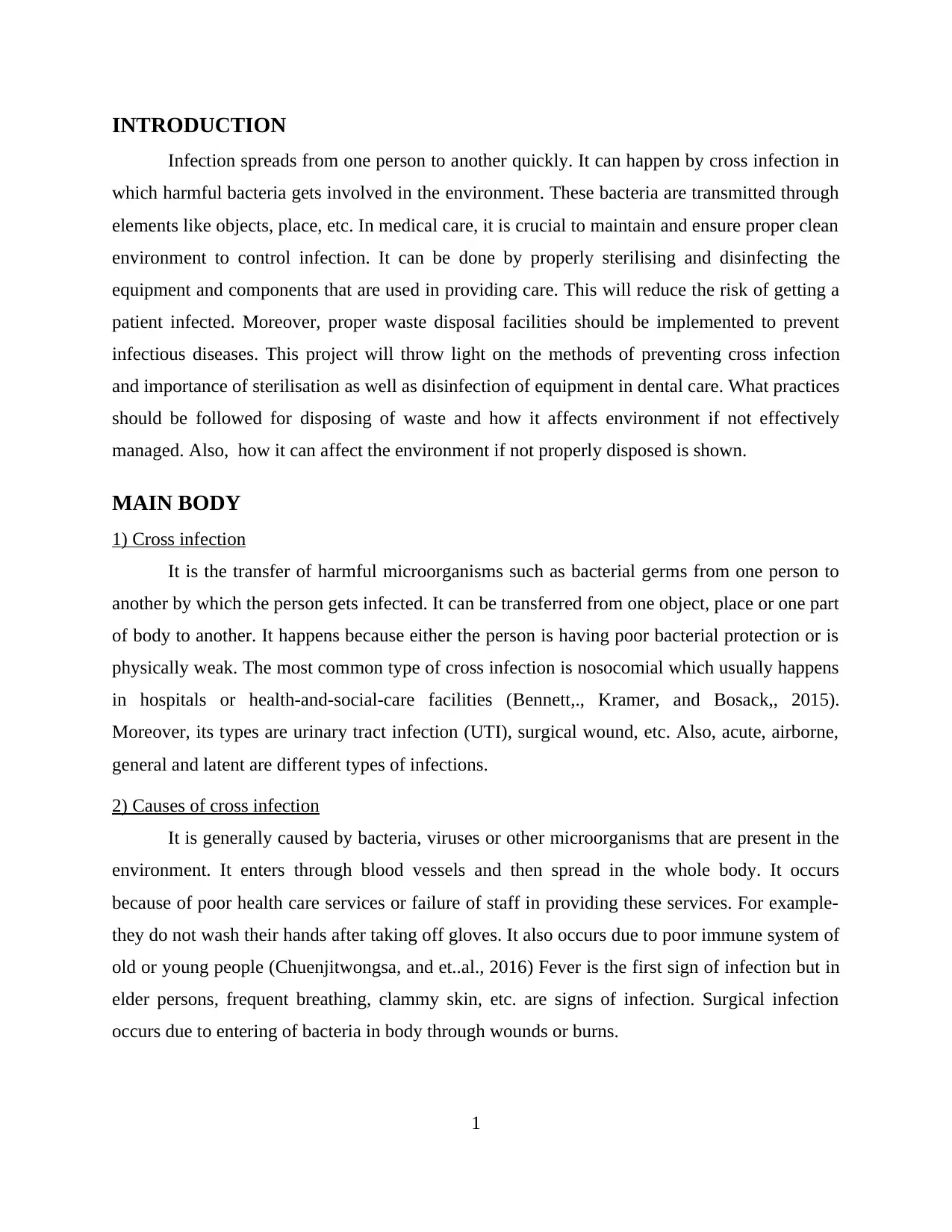
INTRODUCTION
Infection spreads from one person to another quickly. It can happen by cross infection in
which harmful bacteria gets involved in the environment. These bacteria are transmitted through
elements like objects, place, etc. In medical care, it is crucial to maintain and ensure proper clean
environment to control infection. It can be done by properly sterilising and disinfecting the
equipment and components that are used in providing care. This will reduce the risk of getting a
patient infected. Moreover, proper waste disposal facilities should be implemented to prevent
infectious diseases. This project will throw light on the methods of preventing cross infection
and importance of sterilisation as well as disinfection of equipment in dental care. What practices
should be followed for disposing of waste and how it affects environment if not effectively
managed. Also, how it can affect the environment if not properly disposed is shown.
MAIN BODY
1) Cross infection
It is the transfer of harmful microorganisms such as bacterial germs from one person to
another by which the person gets infected. It can be transferred from one object, place or one part
of body to another. It happens because either the person is having poor bacterial protection or is
physically weak. The most common type of cross infection is nosocomial which usually happens
in hospitals or health-and-social-care facilities (Bennett,., Kramer, and Bosack,, 2015).
Moreover, its types are urinary tract infection (UTI), surgical wound, etc. Also, acute, airborne,
general and latent are different types of infections.
2) Causes of cross infection
It is generally caused by bacteria, viruses or other microorganisms that are present in the
environment. It enters through blood vessels and then spread in the whole body. It occurs
because of poor health care services or failure of staff in providing these services. For example-
they do not wash their hands after taking off gloves. It also occurs due to poor immune system of
old or young people (Chuenjitwongsa, and et..al., 2016) Fever is the first sign of infection but in
elder persons, frequent breathing, clammy skin, etc. are signs of infection. Surgical infection
occurs due to entering of bacteria in body through wounds or burns.
1
Infection spreads from one person to another quickly. It can happen by cross infection in
which harmful bacteria gets involved in the environment. These bacteria are transmitted through
elements like objects, place, etc. In medical care, it is crucial to maintain and ensure proper clean
environment to control infection. It can be done by properly sterilising and disinfecting the
equipment and components that are used in providing care. This will reduce the risk of getting a
patient infected. Moreover, proper waste disposal facilities should be implemented to prevent
infectious diseases. This project will throw light on the methods of preventing cross infection
and importance of sterilisation as well as disinfection of equipment in dental care. What practices
should be followed for disposing of waste and how it affects environment if not effectively
managed. Also, how it can affect the environment if not properly disposed is shown.
MAIN BODY
1) Cross infection
It is the transfer of harmful microorganisms such as bacterial germs from one person to
another by which the person gets infected. It can be transferred from one object, place or one part
of body to another. It happens because either the person is having poor bacterial protection or is
physically weak. The most common type of cross infection is nosocomial which usually happens
in hospitals or health-and-social-care facilities (Bennett,., Kramer, and Bosack,, 2015).
Moreover, its types are urinary tract infection (UTI), surgical wound, etc. Also, acute, airborne,
general and latent are different types of infections.
2) Causes of cross infection
It is generally caused by bacteria, viruses or other microorganisms that are present in the
environment. It enters through blood vessels and then spread in the whole body. It occurs
because of poor health care services or failure of staff in providing these services. For example-
they do not wash their hands after taking off gloves. It also occurs due to poor immune system of
old or young people (Chuenjitwongsa, and et..al., 2016) Fever is the first sign of infection but in
elder persons, frequent breathing, clammy skin, etc. are signs of infection. Surgical infection
occurs due to entering of bacteria in body through wounds or burns.
1
⊘ This is a preview!⊘
Do you want full access?
Subscribe today to unlock all pages.

Trusted by 1+ million students worldwide
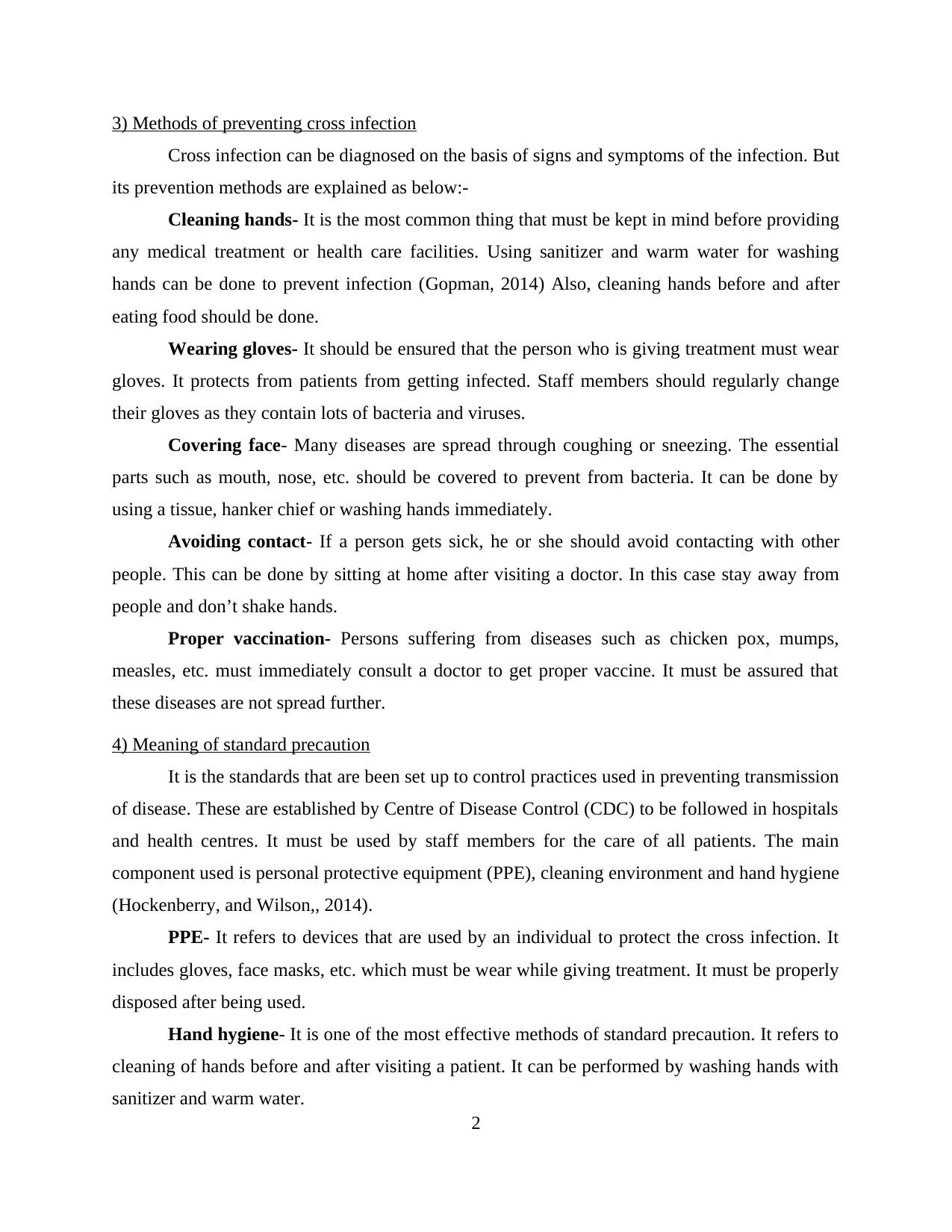
3) Methods of preventing cross infection
Cross infection can be diagnosed on the basis of signs and symptoms of the infection. But
its prevention methods are explained as below:-
Cleaning hands- It is the most common thing that must be kept in mind before providing
any medical treatment or health care facilities. Using sanitizer and warm water for washing
hands can be done to prevent infection (Gopman, 2014) Also, cleaning hands before and after
eating food should be done.
Wearing gloves- It should be ensured that the person who is giving treatment must wear
gloves. It protects from patients from getting infected. Staff members should regularly change
their gloves as they contain lots of bacteria and viruses.
Covering face- Many diseases are spread through coughing or sneezing. The essential
parts such as mouth, nose, etc. should be covered to prevent from bacteria. It can be done by
using a tissue, hanker chief or washing hands immediately.
Avoiding contact- If a person gets sick, he or she should avoid contacting with other
people. This can be done by sitting at home after visiting a doctor. In this case stay away from
people and don’t shake hands.
Proper vaccination- Persons suffering from diseases such as chicken pox, mumps,
measles, etc. must immediately consult a doctor to get proper vaccine. It must be assured that
these diseases are not spread further.
4) Meaning of standard precaution
It is the standards that are been set up to control practices used in preventing transmission
of disease. These are established by Centre of Disease Control (CDC) to be followed in hospitals
and health centres. It must be used by staff members for the care of all patients. The main
component used is personal protective equipment (PPE), cleaning environment and hand hygiene
(Hockenberry, and Wilson,, 2014).
PPE- It refers to devices that are used by an individual to protect the cross infection. It
includes gloves, face masks, etc. which must be wear while giving treatment. It must be properly
disposed after being used.
Hand hygiene- It is one of the most effective methods of standard precaution. It refers to
cleaning of hands before and after visiting a patient. It can be performed by washing hands with
sanitizer and warm water.
2
Cross infection can be diagnosed on the basis of signs and symptoms of the infection. But
its prevention methods are explained as below:-
Cleaning hands- It is the most common thing that must be kept in mind before providing
any medical treatment or health care facilities. Using sanitizer and warm water for washing
hands can be done to prevent infection (Gopman, 2014) Also, cleaning hands before and after
eating food should be done.
Wearing gloves- It should be ensured that the person who is giving treatment must wear
gloves. It protects from patients from getting infected. Staff members should regularly change
their gloves as they contain lots of bacteria and viruses.
Covering face- Many diseases are spread through coughing or sneezing. The essential
parts such as mouth, nose, etc. should be covered to prevent from bacteria. It can be done by
using a tissue, hanker chief or washing hands immediately.
Avoiding contact- If a person gets sick, he or she should avoid contacting with other
people. This can be done by sitting at home after visiting a doctor. In this case stay away from
people and don’t shake hands.
Proper vaccination- Persons suffering from diseases such as chicken pox, mumps,
measles, etc. must immediately consult a doctor to get proper vaccine. It must be assured that
these diseases are not spread further.
4) Meaning of standard precaution
It is the standards that are been set up to control practices used in preventing transmission
of disease. These are established by Centre of Disease Control (CDC) to be followed in hospitals
and health centres. It must be used by staff members for the care of all patients. The main
component used is personal protective equipment (PPE), cleaning environment and hand hygiene
(Hockenberry, and Wilson,, 2014).
PPE- It refers to devices that are used by an individual to protect the cross infection. It
includes gloves, face masks, etc. which must be wear while giving treatment. It must be properly
disposed after being used.
Hand hygiene- It is one of the most effective methods of standard precaution. It refers to
cleaning of hands before and after visiting a patient. It can be performed by washing hands with
sanitizer and warm water.
2
Paraphrase This Document
Need a fresh take? Get an instant paraphrase of this document with our AI Paraphraser
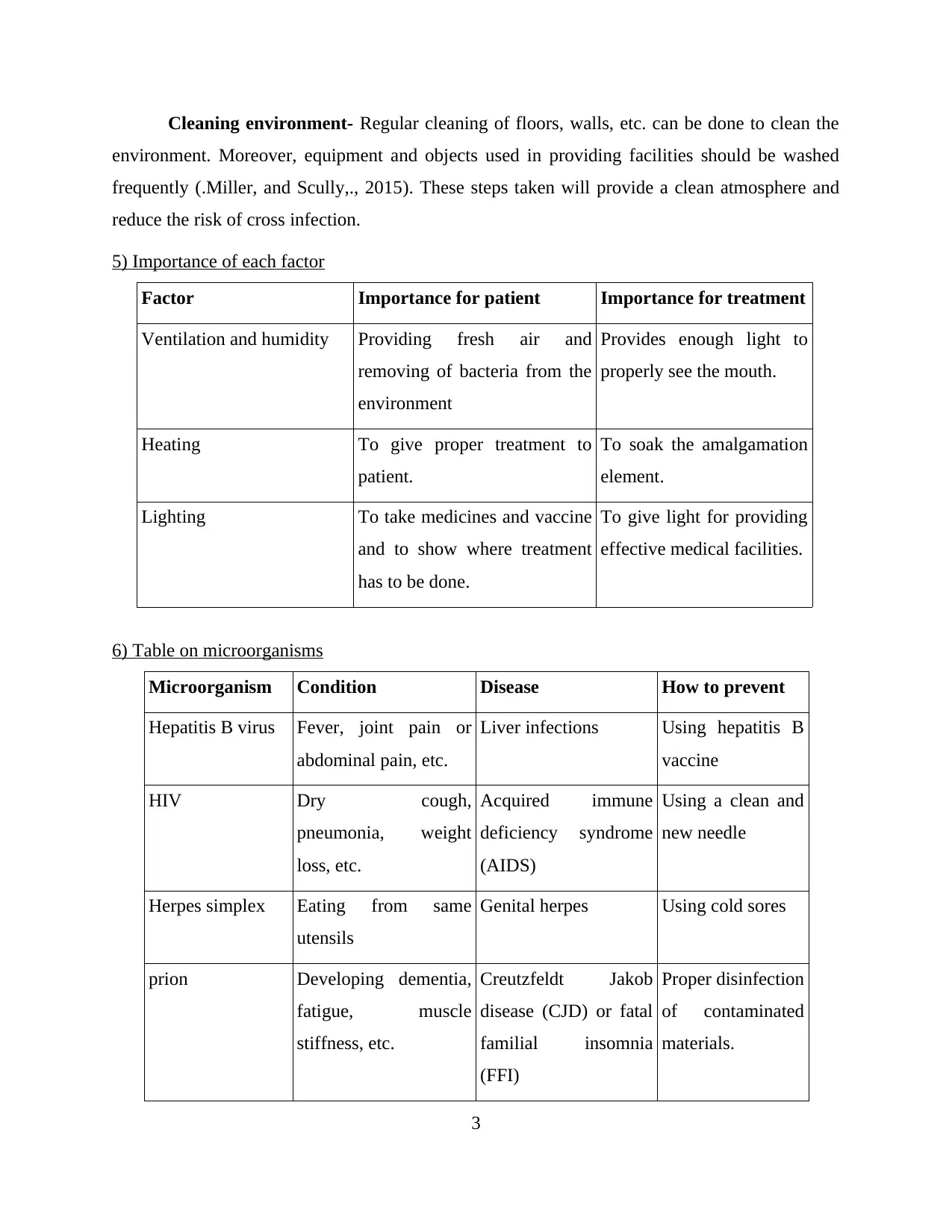
Cleaning environment- Regular cleaning of floors, walls, etc. can be done to clean the
environment. Moreover, equipment and objects used in providing facilities should be washed
frequently (.Miller, and Scully,., 2015). These steps taken will provide a clean atmosphere and
reduce the risk of cross infection.
5) Importance of each factor
Factor Importance for patient Importance for treatment
Ventilation and humidity Providing fresh air and
removing of bacteria from the
environment
Provides enough light to
properly see the mouth.
Heating To give proper treatment to
patient.
To soak the amalgamation
element.
Lighting To take medicines and vaccine
and to show where treatment
has to be done.
To give light for providing
effective medical facilities.
6) Table on microorganisms
Microorganism Condition Disease How to prevent
Hepatitis B virus Fever, joint pain or
abdominal pain, etc.
Liver infections Using hepatitis B
vaccine
HIV Dry cough,
pneumonia, weight
loss, etc.
Acquired immune
deficiency syndrome
(AIDS)
Using a clean and
new needle
Herpes simplex Eating from same
utensils
Genital herpes Using cold sores
prion Developing dementia,
fatigue, muscle
stiffness, etc.
Creutzfeldt Jakob
disease (CJD) or fatal
familial insomnia
(FFI)
Proper disinfection
of contaminated
materials.
3
environment. Moreover, equipment and objects used in providing facilities should be washed
frequently (.Miller, and Scully,., 2015). These steps taken will provide a clean atmosphere and
reduce the risk of cross infection.
5) Importance of each factor
Factor Importance for patient Importance for treatment
Ventilation and humidity Providing fresh air and
removing of bacteria from the
environment
Provides enough light to
properly see the mouth.
Heating To give proper treatment to
patient.
To soak the amalgamation
element.
Lighting To take medicines and vaccine
and to show where treatment
has to be done.
To give light for providing
effective medical facilities.
6) Table on microorganisms
Microorganism Condition Disease How to prevent
Hepatitis B virus Fever, joint pain or
abdominal pain, etc.
Liver infections Using hepatitis B
vaccine
HIV Dry cough,
pneumonia, weight
loss, etc.
Acquired immune
deficiency syndrome
(AIDS)
Using a clean and
new needle
Herpes simplex Eating from same
utensils
Genital herpes Using cold sores
prion Developing dementia,
fatigue, muscle
stiffness, etc.
Creutzfeldt Jakob
disease (CJD) or fatal
familial insomnia
(FFI)
Proper disinfection
of contaminated
materials.
3
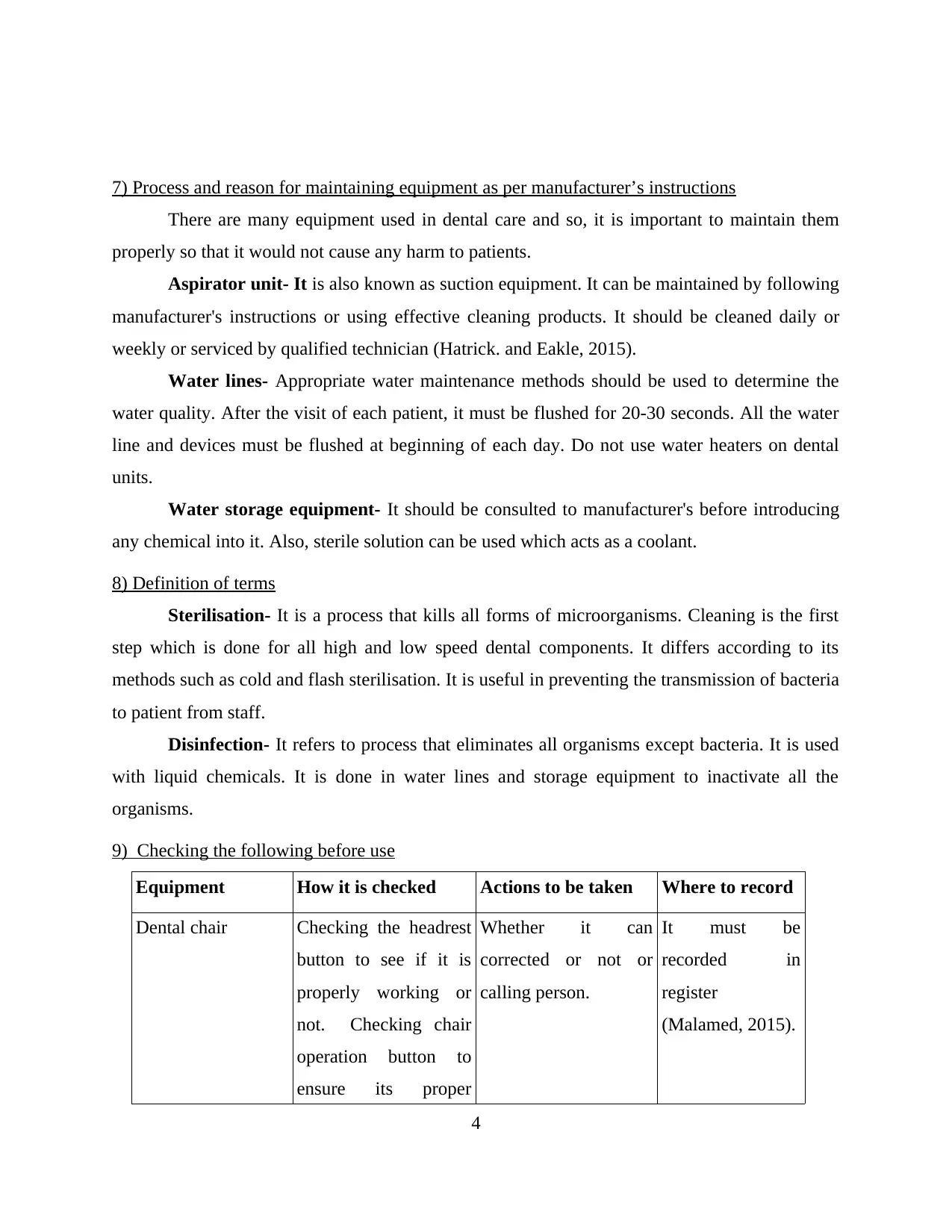
7) Process and reason for maintaining equipment as per manufacturer’s instructions
There are many equipment used in dental care and so, it is important to maintain them
properly so that it would not cause any harm to patients.
Aspirator unit- It is also known as suction equipment. It can be maintained by following
manufacturer's instructions or using effective cleaning products. It should be cleaned daily or
weekly or serviced by qualified technician (Hatrick. and Eakle, 2015).
Water lines- Appropriate water maintenance methods should be used to determine the
water quality. After the visit of each patient, it must be flushed for 20-30 seconds. All the water
line and devices must be flushed at beginning of each day. Do not use water heaters on dental
units.
Water storage equipment- It should be consulted to manufacturer's before introducing
any chemical into it. Also, sterile solution can be used which acts as a coolant.
8) Definition of terms
Sterilisation- It is a process that kills all forms of microorganisms. Cleaning is the first
step which is done for all high and low speed dental components. It differs according to its
methods such as cold and flash sterilisation. It is useful in preventing the transmission of bacteria
to patient from staff.
Disinfection- It refers to process that eliminates all organisms except bacteria. It is used
with liquid chemicals. It is done in water lines and storage equipment to inactivate all the
organisms.
9) Checking the following before use
Equipment How it is checked Actions to be taken Where to record
Dental chair Checking the headrest
button to see if it is
properly working or
not. Checking chair
operation button to
ensure its proper
Whether it can
corrected or not or
calling person.
It must be
recorded in
register
(Malamed, 2015).
4
There are many equipment used in dental care and so, it is important to maintain them
properly so that it would not cause any harm to patients.
Aspirator unit- It is also known as suction equipment. It can be maintained by following
manufacturer's instructions or using effective cleaning products. It should be cleaned daily or
weekly or serviced by qualified technician (Hatrick. and Eakle, 2015).
Water lines- Appropriate water maintenance methods should be used to determine the
water quality. After the visit of each patient, it must be flushed for 20-30 seconds. All the water
line and devices must be flushed at beginning of each day. Do not use water heaters on dental
units.
Water storage equipment- It should be consulted to manufacturer's before introducing
any chemical into it. Also, sterile solution can be used which acts as a coolant.
8) Definition of terms
Sterilisation- It is a process that kills all forms of microorganisms. Cleaning is the first
step which is done for all high and low speed dental components. It differs according to its
methods such as cold and flash sterilisation. It is useful in preventing the transmission of bacteria
to patient from staff.
Disinfection- It refers to process that eliminates all organisms except bacteria. It is used
with liquid chemicals. It is done in water lines and storage equipment to inactivate all the
organisms.
9) Checking the following before use
Equipment How it is checked Actions to be taken Where to record
Dental chair Checking the headrest
button to see if it is
properly working or
not. Checking chair
operation button to
ensure its proper
Whether it can
corrected or not or
calling person.
It must be
recorded in
register
(Malamed, 2015).
4
⊘ This is a preview!⊘
Do you want full access?
Subscribe today to unlock all pages.

Trusted by 1+ million students worldwide
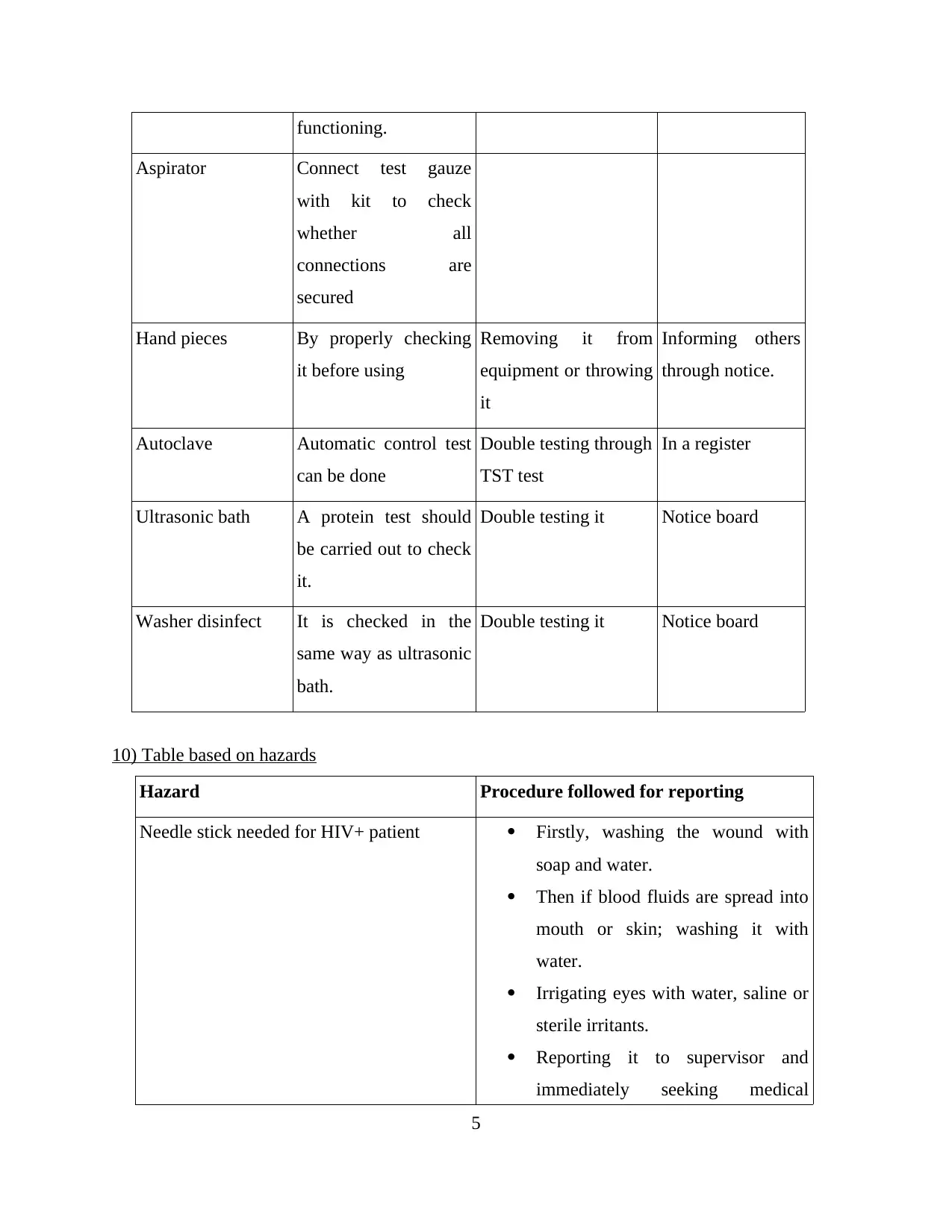
functioning.
Aspirator Connect test gauze
with kit to check
whether all
connections are
secured
Hand pieces By properly checking
it before using
Removing it from
equipment or throwing
it
Informing others
through notice.
Autoclave Automatic control test
can be done
Double testing through
TST test
In a register
Ultrasonic bath A protein test should
be carried out to check
it.
Double testing it Notice board
Washer disinfect It is checked in the
same way as ultrasonic
bath.
Double testing it Notice board
10) Table based on hazards
Hazard Procedure followed for reporting
Needle stick needed for HIV+ patient Firstly, washing the wound with
soap and water.
Then if blood fluids are spread into
mouth or skin; washing it with
water.
Irrigating eyes with water, saline or
sterile irritants.
Reporting it to supervisor and
immediately seeking medical
5
Aspirator Connect test gauze
with kit to check
whether all
connections are
secured
Hand pieces By properly checking
it before using
Removing it from
equipment or throwing
it
Informing others
through notice.
Autoclave Automatic control test
can be done
Double testing through
TST test
In a register
Ultrasonic bath A protein test should
be carried out to check
it.
Double testing it Notice board
Washer disinfect It is checked in the
same way as ultrasonic
bath.
Double testing it Notice board
10) Table based on hazards
Hazard Procedure followed for reporting
Needle stick needed for HIV+ patient Firstly, washing the wound with
soap and water.
Then if blood fluids are spread into
mouth or skin; washing it with
water.
Irrigating eyes with water, saline or
sterile irritants.
Reporting it to supervisor and
immediately seeking medical
5
Paraphrase This Document
Need a fresh take? Get an instant paraphrase of this document with our AI Paraphraser
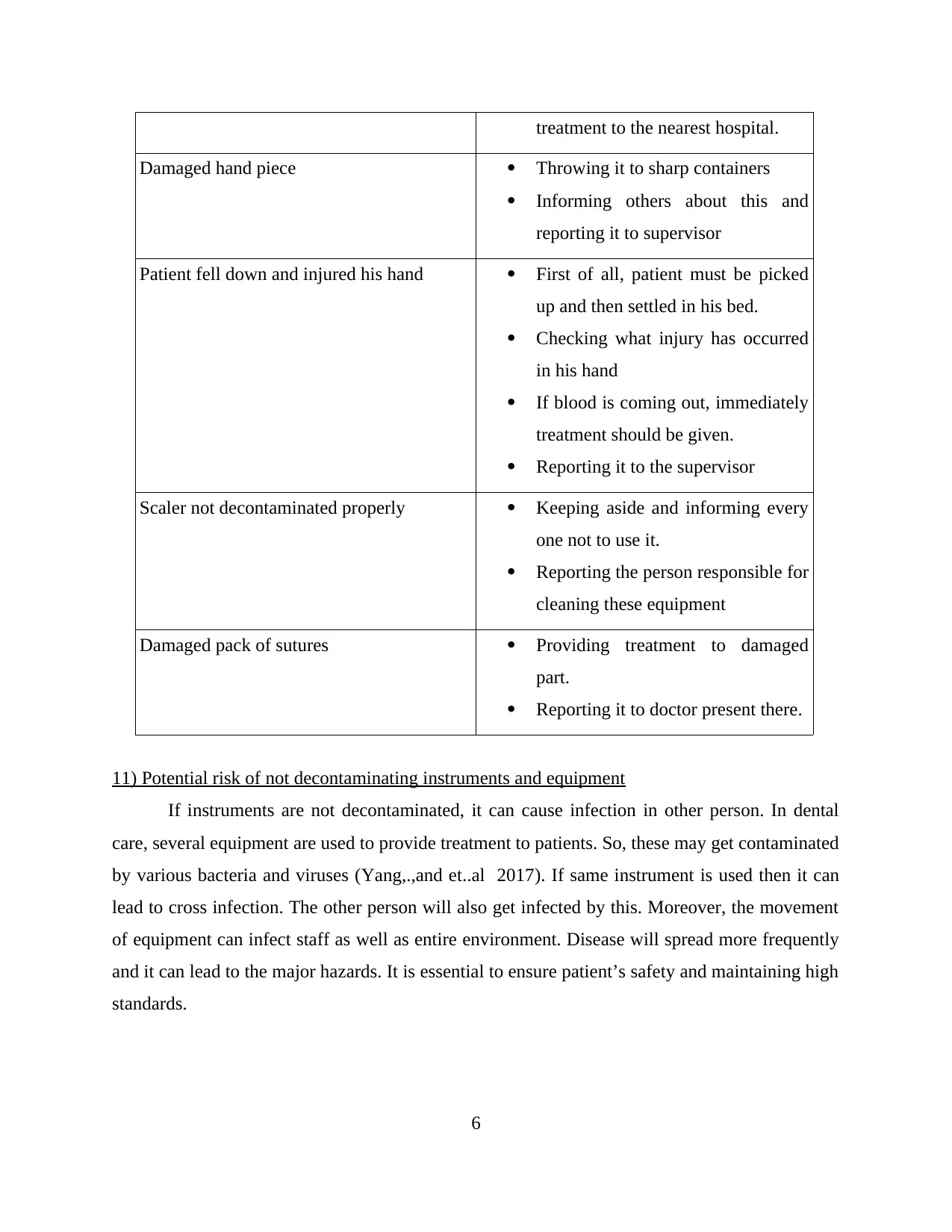
treatment to the nearest hospital.
Damaged hand piece Throwing it to sharp containers
Informing others about this and
reporting it to supervisor
Patient fell down and injured his hand First of all, patient must be picked
up and then settled in his bed.
Checking what injury has occurred
in his hand
If blood is coming out, immediately
treatment should be given.
Reporting it to the supervisor
Scaler not decontaminated properly Keeping aside and informing every
one not to use it.
Reporting the person responsible for
cleaning these equipment
Damaged pack of sutures Providing treatment to damaged
part.
Reporting it to doctor present there.
11) Potential risk of not decontaminating instruments and equipment
If instruments are not decontaminated, it can cause infection in other person. In dental
care, several equipment are used to provide treatment to patients. So, these may get contaminated
by various bacteria and viruses (Yang,.,and et..al 2017). If same instrument is used then it can
lead to cross infection. The other person will also get infected by this. Moreover, the movement
of equipment can infect staff as well as entire environment. Disease will spread more frequently
and it can lead to the major hazards. It is essential to ensure patient’s safety and maintaining high
standards.
6
Damaged hand piece Throwing it to sharp containers
Informing others about this and
reporting it to supervisor
Patient fell down and injured his hand First of all, patient must be picked
up and then settled in his bed.
Checking what injury has occurred
in his hand
If blood is coming out, immediately
treatment should be given.
Reporting it to the supervisor
Scaler not decontaminated properly Keeping aside and informing every
one not to use it.
Reporting the person responsible for
cleaning these equipment
Damaged pack of sutures Providing treatment to damaged
part.
Reporting it to doctor present there.
11) Potential risk of not decontaminating instruments and equipment
If instruments are not decontaminated, it can cause infection in other person. In dental
care, several equipment are used to provide treatment to patients. So, these may get contaminated
by various bacteria and viruses (Yang,.,and et..al 2017). If same instrument is used then it can
lead to cross infection. The other person will also get infected by this. Moreover, the movement
of equipment can infect staff as well as entire environment. Disease will spread more frequently
and it can lead to the major hazards. It is essential to ensure patient’s safety and maintaining high
standards.
6
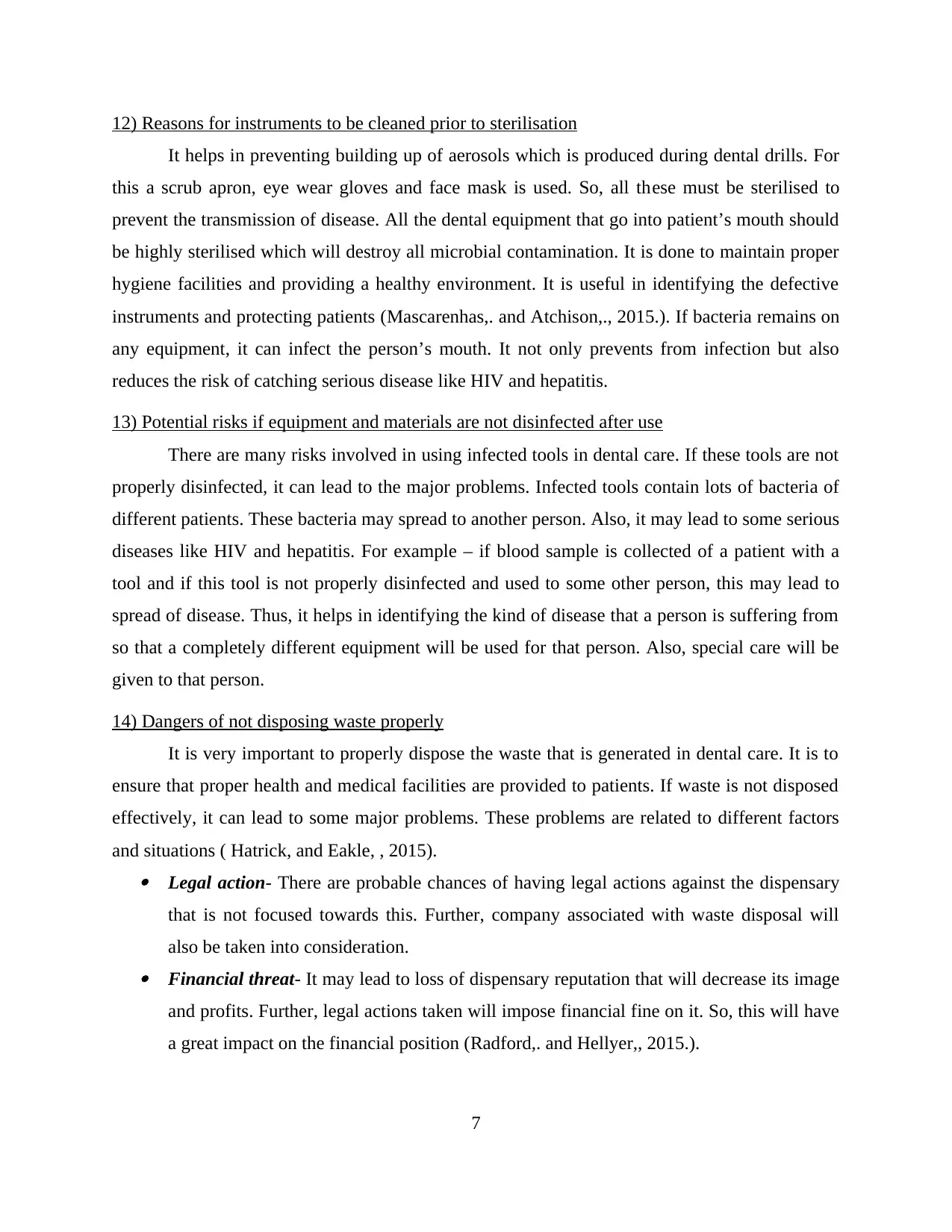
12) Reasons for instruments to be cleaned prior to sterilisation
It helps in preventing building up of aerosols which is produced during dental drills. For
this a scrub apron, eye wear gloves and face mask is used. So, all these must be sterilised to
prevent the transmission of disease. All the dental equipment that go into patient’s mouth should
be highly sterilised which will destroy all microbial contamination. It is done to maintain proper
hygiene facilities and providing a healthy environment. It is useful in identifying the defective
instruments and protecting patients (Mascarenhas,. and Atchison,., 2015.). If bacteria remains on
any equipment, it can infect the person’s mouth. It not only prevents from infection but also
reduces the risk of catching serious disease like HIV and hepatitis.
13) Potential risks if equipment and materials are not disinfected after use
There are many risks involved in using infected tools in dental care. If these tools are not
properly disinfected, it can lead to the major problems. Infected tools contain lots of bacteria of
different patients. These bacteria may spread to another person. Also, it may lead to some serious
diseases like HIV and hepatitis. For example – if blood sample is collected of a patient with a
tool and if this tool is not properly disinfected and used to some other person, this may lead to
spread of disease. Thus, it helps in identifying the kind of disease that a person is suffering from
so that a completely different equipment will be used for that person. Also, special care will be
given to that person.
14) Dangers of not disposing waste properly
It is very important to properly dispose the waste that is generated in dental care. It is to
ensure that proper health and medical facilities are provided to patients. If waste is not disposed
effectively, it can lead to some major problems. These problems are related to different factors
and situations ( Hatrick, and Eakle, , 2015). Legal action- There are probable chances of having legal actions against the dispensary
that is not focused towards this. Further, company associated with waste disposal will
also be taken into consideration. Financial threat- It may lead to loss of dispensary reputation that will decrease its image
and profits. Further, legal actions taken will impose financial fine on it. So, this will have
a great impact on the financial position (Radford,. and Hellyer,, 2015.).
7
It helps in preventing building up of aerosols which is produced during dental drills. For
this a scrub apron, eye wear gloves and face mask is used. So, all these must be sterilised to
prevent the transmission of disease. All the dental equipment that go into patient’s mouth should
be highly sterilised which will destroy all microbial contamination. It is done to maintain proper
hygiene facilities and providing a healthy environment. It is useful in identifying the defective
instruments and protecting patients (Mascarenhas,. and Atchison,., 2015.). If bacteria remains on
any equipment, it can infect the person’s mouth. It not only prevents from infection but also
reduces the risk of catching serious disease like HIV and hepatitis.
13) Potential risks if equipment and materials are not disinfected after use
There are many risks involved in using infected tools in dental care. If these tools are not
properly disinfected, it can lead to the major problems. Infected tools contain lots of bacteria of
different patients. These bacteria may spread to another person. Also, it may lead to some serious
diseases like HIV and hepatitis. For example – if blood sample is collected of a patient with a
tool and if this tool is not properly disinfected and used to some other person, this may lead to
spread of disease. Thus, it helps in identifying the kind of disease that a person is suffering from
so that a completely different equipment will be used for that person. Also, special care will be
given to that person.
14) Dangers of not disposing waste properly
It is very important to properly dispose the waste that is generated in dental care. It is to
ensure that proper health and medical facilities are provided to patients. If waste is not disposed
effectively, it can lead to some major problems. These problems are related to different factors
and situations ( Hatrick, and Eakle, , 2015). Legal action- There are probable chances of having legal actions against the dispensary
that is not focused towards this. Further, company associated with waste disposal will
also be taken into consideration. Financial threat- It may lead to loss of dispensary reputation that will decrease its image
and profits. Further, legal actions taken will impose financial fine on it. So, this will have
a great impact on the financial position (Radford,. and Hellyer,, 2015.).
7
⊘ This is a preview!⊘
Do you want full access?
Subscribe today to unlock all pages.

Trusted by 1+ million students worldwide
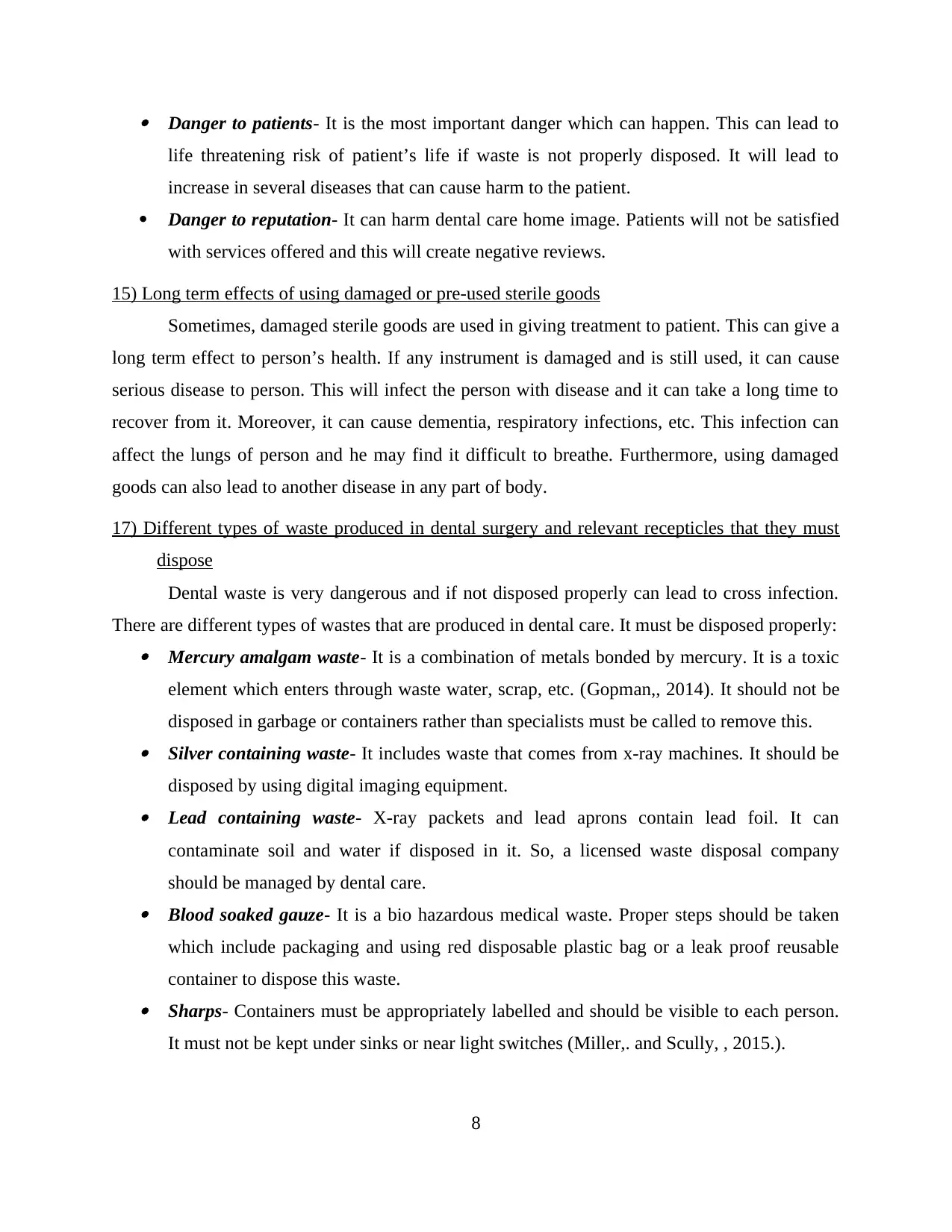
Danger to patients- It is the most important danger which can happen. This can lead to
life threatening risk of patient’s life if waste is not properly disposed. It will lead to
increase in several diseases that can cause harm to the patient.
Danger to reputation- It can harm dental care home image. Patients will not be satisfied
with services offered and this will create negative reviews.
15) Long term effects of using damaged or pre-used sterile goods
Sometimes, damaged sterile goods are used in giving treatment to patient. This can give a
long term effect to person’s health. If any instrument is damaged and is still used, it can cause
serious disease to person. This will infect the person with disease and it can take a long time to
recover from it. Moreover, it can cause dementia, respiratory infections, etc. This infection can
affect the lungs of person and he may find it difficult to breathe. Furthermore, using damaged
goods can also lead to another disease in any part of body.
17) Different types of waste produced in dental surgery and relevant recepticles that they must
dispose
Dental waste is very dangerous and if not disposed properly can lead to cross infection.
There are different types of wastes that are produced in dental care. It must be disposed properly: Mercury amalgam waste- It is a combination of metals bonded by mercury. It is a toxic
element which enters through waste water, scrap, etc. (Gopman,, 2014). It should not be
disposed in garbage or containers rather than specialists must be called to remove this. Silver containing waste- It includes waste that comes from x-ray machines. It should be
disposed by using digital imaging equipment. Lead containing waste- X-ray packets and lead aprons contain lead foil. It can
contaminate soil and water if disposed in it. So, a licensed waste disposal company
should be managed by dental care. Blood soaked gauze- It is a bio hazardous medical waste. Proper steps should be taken
which include packaging and using red disposable plastic bag or a leak proof reusable
container to dispose this waste. Sharps- Containers must be appropriately labelled and should be visible to each person.
It must not be kept under sinks or near light switches (Miller,. and Scully, , 2015.).
8
life threatening risk of patient’s life if waste is not properly disposed. It will lead to
increase in several diseases that can cause harm to the patient.
Danger to reputation- It can harm dental care home image. Patients will not be satisfied
with services offered and this will create negative reviews.
15) Long term effects of using damaged or pre-used sterile goods
Sometimes, damaged sterile goods are used in giving treatment to patient. This can give a
long term effect to person’s health. If any instrument is damaged and is still used, it can cause
serious disease to person. This will infect the person with disease and it can take a long time to
recover from it. Moreover, it can cause dementia, respiratory infections, etc. This infection can
affect the lungs of person and he may find it difficult to breathe. Furthermore, using damaged
goods can also lead to another disease in any part of body.
17) Different types of waste produced in dental surgery and relevant recepticles that they must
dispose
Dental waste is very dangerous and if not disposed properly can lead to cross infection.
There are different types of wastes that are produced in dental care. It must be disposed properly: Mercury amalgam waste- It is a combination of metals bonded by mercury. It is a toxic
element which enters through waste water, scrap, etc. (Gopman,, 2014). It should not be
disposed in garbage or containers rather than specialists must be called to remove this. Silver containing waste- It includes waste that comes from x-ray machines. It should be
disposed by using digital imaging equipment. Lead containing waste- X-ray packets and lead aprons contain lead foil. It can
contaminate soil and water if disposed in it. So, a licensed waste disposal company
should be managed by dental care. Blood soaked gauze- It is a bio hazardous medical waste. Proper steps should be taken
which include packaging and using red disposable plastic bag or a leak proof reusable
container to dispose this waste. Sharps- Containers must be appropriately labelled and should be visible to each person.
It must not be kept under sinks or near light switches (Miller,. and Scully, , 2015.).
8
Paraphrase This Document
Need a fresh take? Get an instant paraphrase of this document with our AI Paraphraser
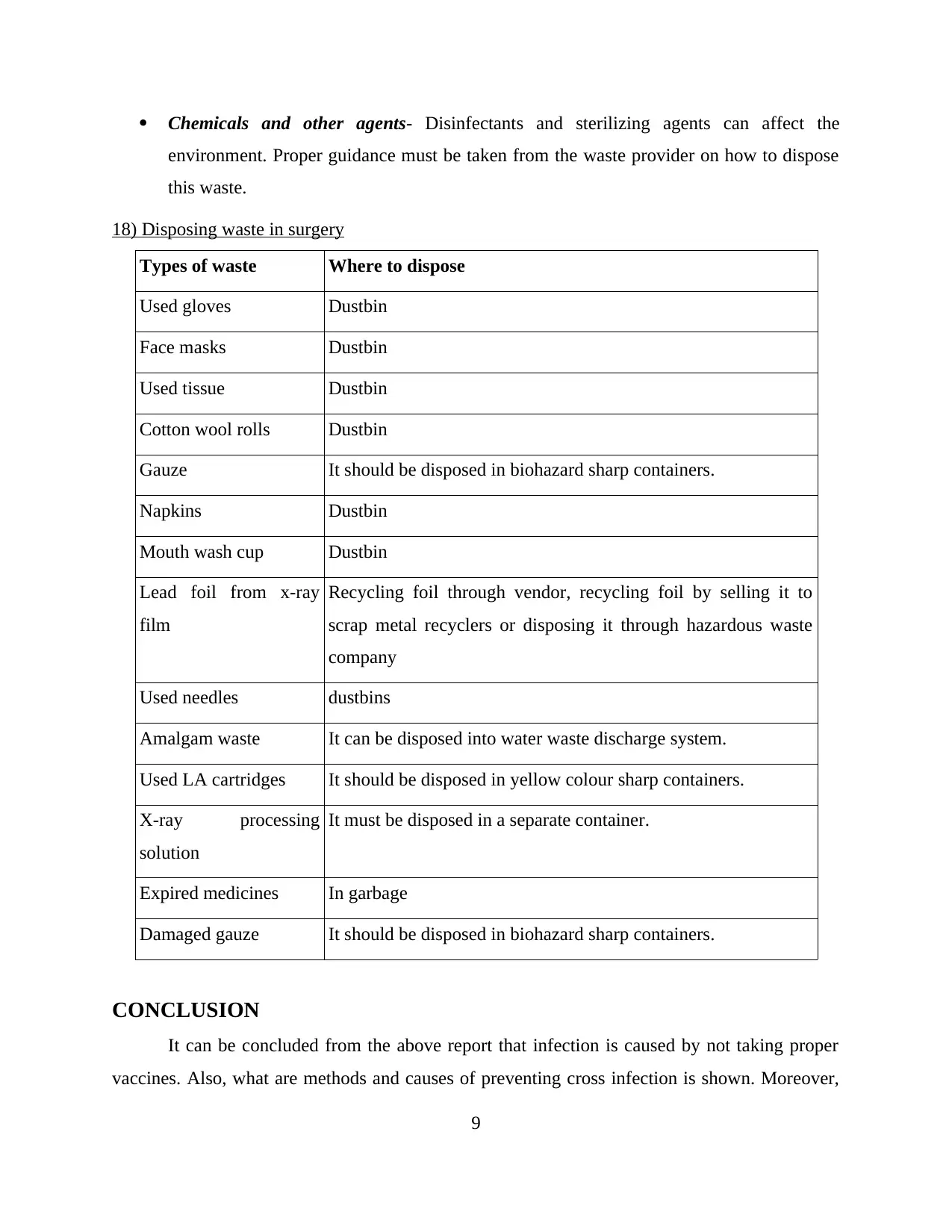
Chemicals and other agents- Disinfectants and sterilizing agents can affect the
environment. Proper guidance must be taken from the waste provider on how to dispose
this waste.
18) Disposing waste in surgery
Types of waste Where to dispose
Used gloves Dustbin
Face masks Dustbin
Used tissue Dustbin
Cotton wool rolls Dustbin
Gauze It should be disposed in biohazard sharp containers.
Napkins Dustbin
Mouth wash cup Dustbin
Lead foil from x-ray
film
Recycling foil through vendor, recycling foil by selling it to
scrap metal recyclers or disposing it through hazardous waste
company
Used needles dustbins
Amalgam waste It can be disposed into water waste discharge system.
Used LA cartridges It should be disposed in yellow colour sharp containers.
X-ray processing
solution
It must be disposed in a separate container.
Expired medicines In garbage
Damaged gauze It should be disposed in biohazard sharp containers.
CONCLUSION
It can be concluded from the above report that infection is caused by not taking proper
vaccines. Also, what are methods and causes of preventing cross infection is shown. Moreover,
9
environment. Proper guidance must be taken from the waste provider on how to dispose
this waste.
18) Disposing waste in surgery
Types of waste Where to dispose
Used gloves Dustbin
Face masks Dustbin
Used tissue Dustbin
Cotton wool rolls Dustbin
Gauze It should be disposed in biohazard sharp containers.
Napkins Dustbin
Mouth wash cup Dustbin
Lead foil from x-ray
film
Recycling foil through vendor, recycling foil by selling it to
scrap metal recyclers or disposing it through hazardous waste
company
Used needles dustbins
Amalgam waste It can be disposed into water waste discharge system.
Used LA cartridges It should be disposed in yellow colour sharp containers.
X-ray processing
solution
It must be disposed in a separate container.
Expired medicines In garbage
Damaged gauze It should be disposed in biohazard sharp containers.
CONCLUSION
It can be concluded from the above report that infection is caused by not taking proper
vaccines. Also, what are methods and causes of preventing cross infection is shown. Moreover,
9
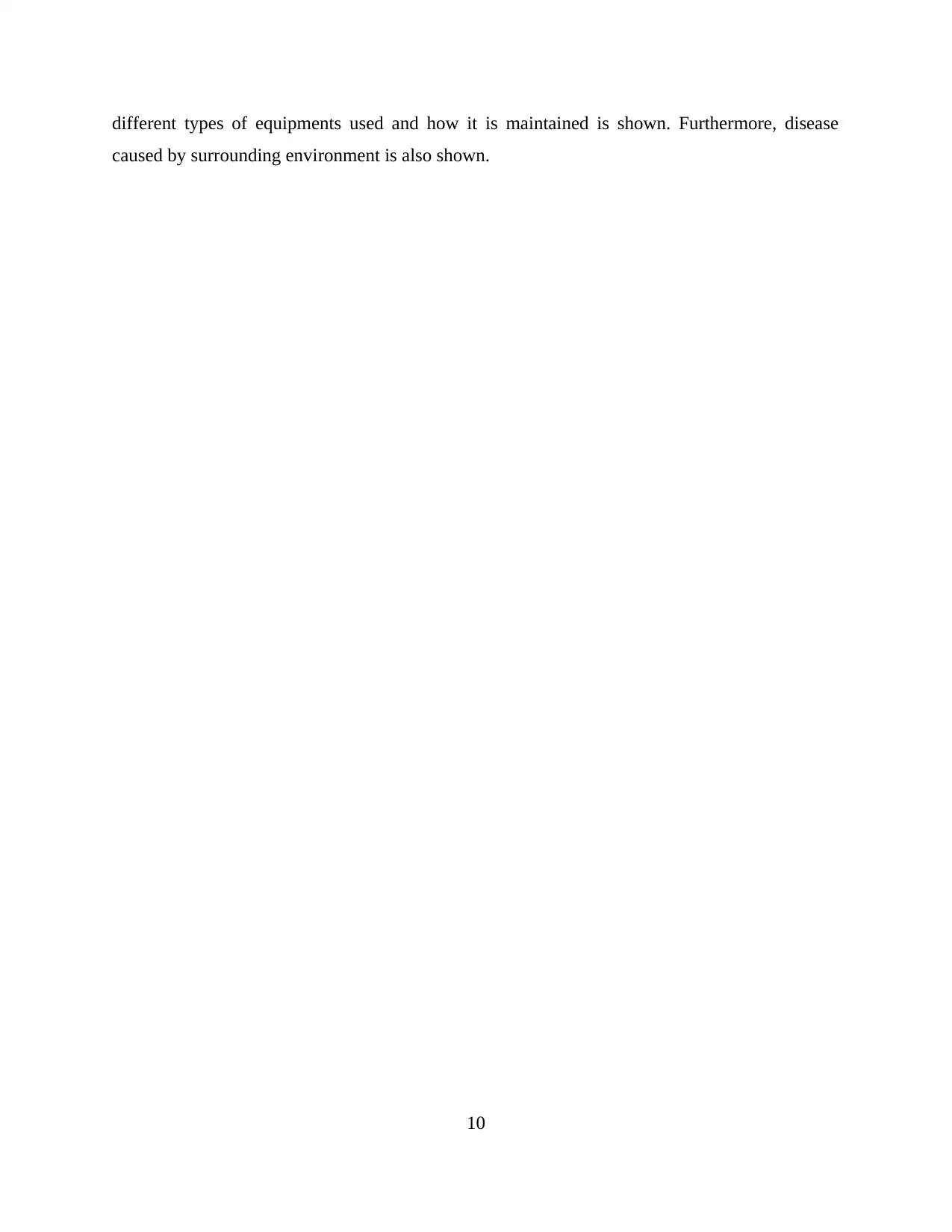
different types of equipments used and how it is maintained is shown. Furthermore, disease
caused by surrounding environment is also shown.
10
caused by surrounding environment is also shown.
10
⊘ This is a preview!⊘
Do you want full access?
Subscribe today to unlock all pages.

Trusted by 1+ million students worldwide
1 out of 12
Related Documents
Your All-in-One AI-Powered Toolkit for Academic Success.
+13062052269
info@desklib.com
Available 24*7 on WhatsApp / Email
![[object Object]](/_next/static/media/star-bottom.7253800d.svg)
Unlock your academic potential
Copyright © 2020–2025 A2Z Services. All Rights Reserved. Developed and managed by ZUCOL.





